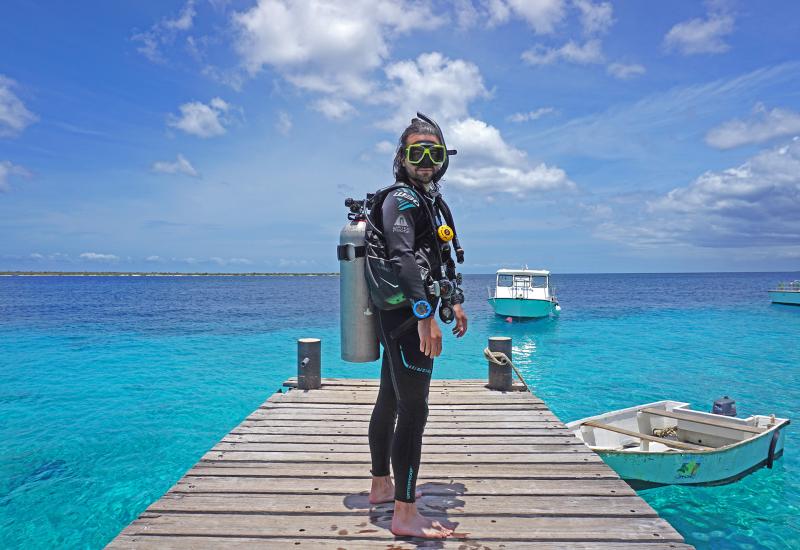Photo Talk - Getting Published
First Steps - The numero uno thing you need to get published is good pictures. This means your pictures must be sharp and properly exposed and have good color. This often requires taking many pictures of the same subject, from slightly different angles and at slightly different exposures, to get the perfect shot. Editors also like pictures that tell a story: a pristine reef, an awesome shipwreck, symbiotic relationships, etc. So when you are looking through your camera's viewfinder, think about Rod Stewart's song, Every Picture Tells a Story. Try to compose your pictures so they can be used to illustrate a point. Of course, pictures that simply convey the beauty of a reef can be best sellers too. Perfect Pitch - When you have some great pictures, you need to send them off to an editor with the all-important pitch letter. Keep in mind that editors are busy as hell and get dozens of pitches a week. Therefore, I suggest making your pitch short and sweet. Send only your very best pictures (spotless, duplicate 35-mm slides, neatly numbered and labeled in an archival slide sheet) along with a one-page idea letter: what makes your pictures different, unique or important. Include another page with captions. Don't send a manuscript. Also include a self-addressed envelope of the right size and with correct postage, or else your pictures may not be returned. You techno geeks (I'm one) might be wondering if it's OK to send your pictures on a Photo CD or zip drive. If you want to invest the time and money, give it a shot. Me? I still send slides. Next, be prepared to wait for a response. I've waited months to hear from editors. My longest wait, seven months, was worth it: I finally got a call from the editor saying his company, Voyageur Press, would publish three of my underwater books within six months. Remember: Patience pays. Don't bug the editor. It will do you no good. Three books, available through www.amazon.com, can help you find out where to send your pictures: The Photographer's Market, The Writer's Market, and Sell and Re-Sell Your Photos. Write Stuff - In the previous paragraph, you might have been a bit puzzled by my mention of The Writer's Market. Well, here's why I recommend it. There are a million underwater photographers out there but only a half-million who write. So if you write, you have a much better chance of getting published. My advice for the first-time writer is this: Write stuff. Write notes, letters, articles and whatever, just write so that you get used to writing. Hey, it's not brain surgery. Real Magic - OK, OK. So I make writing and getting published sound fairly easy. Getting started is not that easy in reality. But you can make it happen, and here's a book that may help you. It's called Real Magic by Wayne Dyer. I recommend this book in all my seminars on getting published and to people who call me to ask advice on getting into print. Basically, Dyer suggests that you can create real magic in your life and live the life you want to live. You can become a good writer, a good underwater photographer, a successful freelancer. Put Nike's way: Just do it! Local News - A good place to start getting your pictures into print is in your local newspaper. That's where I started. After returning from a trip to Belize, Central America, I called the lifestyle editor at the local paper and told her about my adventures and about my underwater pictures. My timing was perfect. The editor needed a cover story for an upcoming section. Two months later, I was on the cover of the lifestyle section: my pictures and my picture. So start small, and don't be afraid to call your local editor. Don't give up, either. Remember, timing is everything in life, especially in the world of publishing. Magazine Sales - Breaking into magazines is a bit harder, because editors have guys like me on whom they can count to deliver good stuff on time. But don't let that stop you from sending in proposals and pictures. Your timing may be right for a picture, photo gallery, article or even a cover. Again, read up on the magazine and its editorial guidelines. And read the magazine cover to cover. This will give you an idea of what the editor likes. Cashin' In - Some of you are probably wondering if you can make a living taking pictures and selling your work. Well, payments are all over the place. Pictures can sell for a few dollars to a few hundred dollars in a magazine, with the price increasing as the circulation increases. Size also matters, with the payment increasing as the size of the print on the page increases. Magazine covers pay very well, from a few hundred dollars to over $1,000. Therefore, when you are framing a picture, think vertical and leave space for type to be placed over your beautiful picture. Article payment also varies, from a few hundred dollars to a few thousand dollars for very upscale magazines. The point to remember is this: You will not become a millionaire selling your work. You will, however, have lots of fun, which is what life is all about. Right? Summing up, I'd like to share with you some advice from Sport Diver's beloved editorial director, Steve Blount: As a freelancer, you have to be faster than everyone who's better than you, and better than everyone who's faster than you. To this I add: You gotta be nicer than everyone, too! P.S. In your quest to get published, try to remember the Zen philosophy: Enjoy the process.Got questions? You can e-mail Rick at [email protected]. When he's not in the field, he'll try to answer you.










